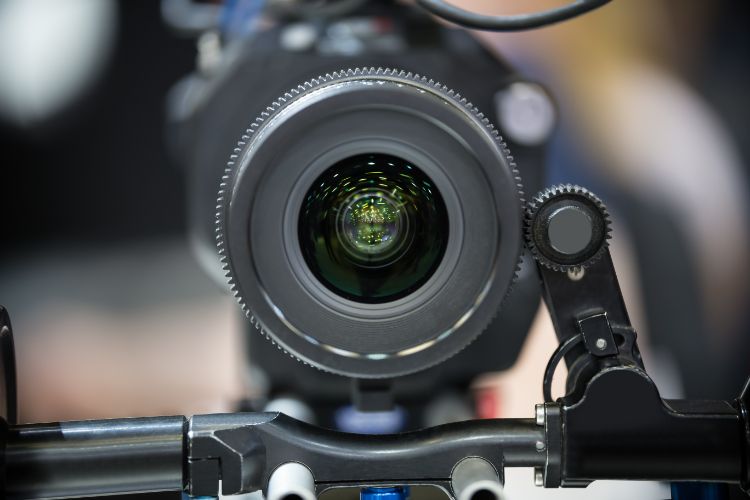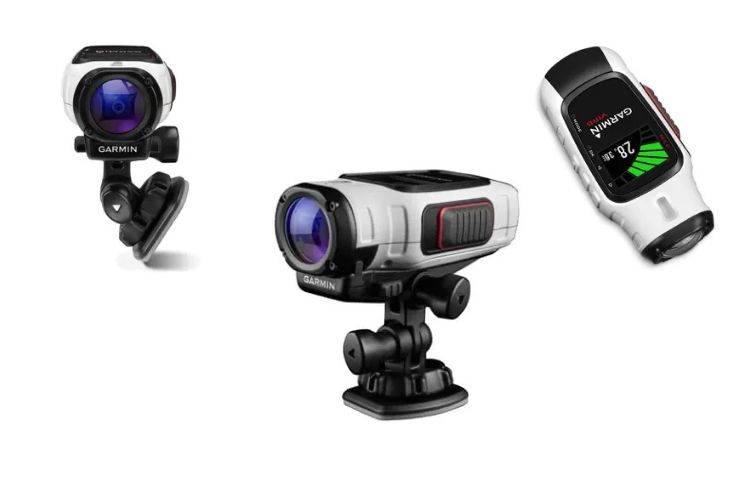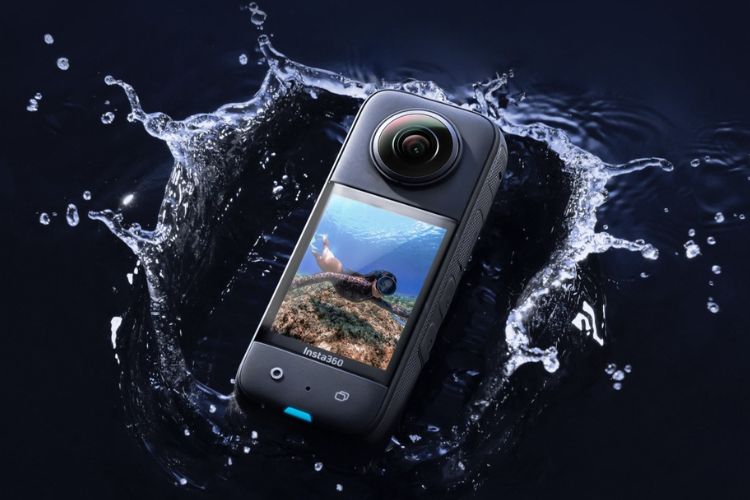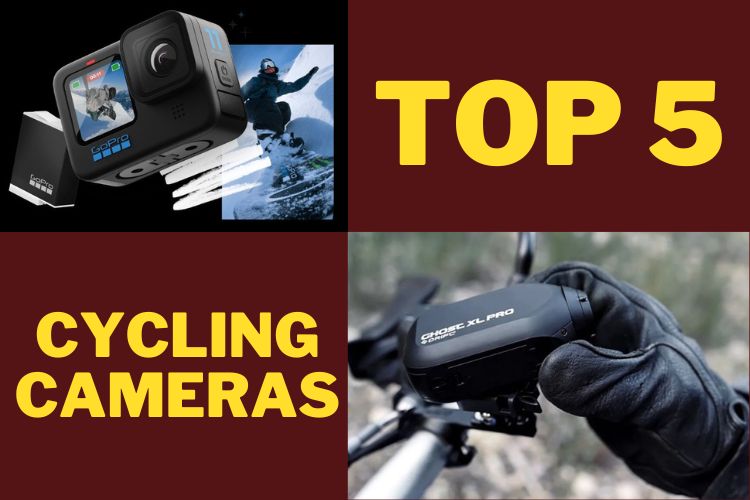The Top 5 Cycling Cameras to Help You Capture Every Adventure
Cycling is an excellent way to get your heart rate up, explore the outdoors, and take in beautiful scenery, like we did in scenic Monument Valley. And what better way to capture all of those memories than with a cycling camera?
After reading this article, you’ll know everything you need to know about the best action cameras on the market for cyclists.
We will also provide a buyer’s guide on the best bike cameras to help you choose the right one for your needs.
Many options exist, but you should consider a few things to find your ideal model. So no matter what type of rider you are, read on to find out which bike camera is right for you.
Before we start with the recommendations, we must familiarize ourselves with a few aspects. Some options might fit better depending on where and how you plan to use the camera.
Things To Consider When Buying A Cycle Camera
Types of Camera Mounting

There are two main mounting options for bike cameras available at the moment. If you are an experienced cyclist and depending on the terrain you are riding on, you could also consider using your phone camera as an action camera to take some shots.
The disadvantage is that mobile phones can be fragile, and video quality will be lower compared to an action camera like a GoPro or Insta360. This is primarily due to the lack of image stabilization in your phone. Therefore, we recommend sticking to one of the mounting systems below.
Handlebar Mount
A handlebar mounting system is the first popular option. This type of mount typically attaches to the handlebars using velcro straps, meaning it can be quickly and easily installed or removed as needed.
Additionally, it is the most comfortable method, in my opinion, because the cycling camera is not attached directly to your body and doesn’t interfere with your movement.
Personally, I like handlebar mount shots if you want to talk to the camera while riding. Lastly, this mounting system will help you to keep an eye on the camera while shooting, which is a great plus.
However, there are also some potential drawbacks to using a handlebar mount. For example, the camera angle is reduced compared to a helmet camera. Also, remember that your handlebar will absorb bumps from the road, so the footage tends to be shaky. Good image stabilization is crucial if you don’t want your video quality compromised.
Helmet Mount
A helmet-mount camera system has several advantages over other types of cycling cameras. First, it gives the rider a clear view of what is ahead, making navigating obstacles easier.
Secondly, it provides a stable platform for recording footage, which is especially important when riding over rough terrain. Finally, your videos usually have a wider camera angle, allowing you to see more in your field of view.
However, there are also some disadvantages to using a helmet-mounted camera system.
For example, if you move your head around too much, it potentially causes the bike camera to shake, resulting in blurred or shaky footage, or it can irritate viewers. Also, on your helmet, bike cameras are more vulnerable to impact in the event of a fall.
Alternative Options
There are two other options I want to introduce here briefly:
- Chest Mount: A chest-mount camera offers a different perspective than handlebar and helmet-mounted action cameras since it is closer to the ground. This action cam system is ideal for filming trails and paths, giving viewers a more immersive experience. The downside is that your arms can get in the way of the shot, depending on how you hold them when riding.
- Bite Adapter: A bite adapter is a relatively new camera mounting system. This allows the rider to mount their camera directly onto their mouthpiece and record footage from a unique perspective. The advantage of this type of filming is that it eliminates all potential shakes or blurriness, resulting in high-quality footage. However, because the location is so close to your face, it will cause some discomfort after a while, so we only recommend it for short sequences.
Image Stabilization
No matter what type of cycling camera you use, image stabilization is a must. This technology reduces the blur and shakes caused by bumps and vibrations, resulting in smoother videos. It also helps to eliminate some of the motion sicknesses caused by watching shaky footage.
Most cameras have an image stabilization function, but some are better than others. One camera that stands out here is the GoPro, whose image stabilization significantly increases the video quality.
Battery Life

When it comes to cycling cameras, battery life is an essential factor. Most cameras have a battery life range between two and five hours, depending on the model. It’s also worth noting that some optional extra features, such as Wi-Fi or GPS, will drastically reduce battery life.
The best models in our list come with removable batteries, so you can carry a spare battery and keep on filming.
Another issue is that some cameras will automatically turn into energy-saving mode after a while. Nothing is more frustrating than finding out that parts of your footage are missing. A handlebar mount camera will allow you to notice it more quickly in case it happens to you.
Ease of Use
Finally, a key factor is how easy a camera is to use. There are cycling cameras that come with complex menus and settings, which can be confusing. I recommend reducing it to the max here. All buttons should be easily accessible, also in case you are wearing gloves.
Best Cycling Cameras for 2023
Now that we’ve covered what to look for when buying a cycling camera let’s look at the best for 2023.
GoPro Hero 11

The GoPro Hero 11 is the company’s flagship camera and the best overall bike camera on the market. It produces stunning video resolution even in dark conditions and has one of the best image stabilization features available. This makes it the perfect choice for capturing your rides in all conditions. Furthermore, compared to the previous models, such as the GoPro Hero 8, there are significant improvements in the video resolution and battery life.
The Hero 11 is also straightforward, with a simple interface that makes it easy to start. Capturing your adventures on a Hero 11 is easy and fun. The camera is very user-friendly, has a simple interface that makes it easy to get started, plus it’s waterproof (to a deph of 33 feet / 10 meters) without needing an additional case.
The image quality is outstanding, with beautiful pictures in all conditions. The new 5.3k video stabilization feature ensures that your photos are always clear and sharp and can give you up to 91% more resolution than 4K technology in older models. My favorite feature is the voice command, where you can operate the camera hands-free and give basic commands.
On the downside, it is more expensive than most other action cameras available but well worth the price. Some users also reported problems with the camera overheating quickly, but the company had the same issue with the previous model and was able to solve it with a software update.
DJI Osmo Action 3

The DJO Osmo Action 3 is a high-quality action cam that offers extended battery life, great image quality, and RockSteady 3.0 technology to stabilize footage. This advanced stabilization system ensures that your images are always clear and sharp, no matter how you hold the camera.
HorizonSteady also locks onto a leveled horizon in every frame, regardless of how the camera is mounted or worn. This makes capturing smooth, stable footage easy, even in the most challenging circumstances. With these innovative features, the DJO Osmo Action 3 is the perfect choice for anyone who wants to capture amazing video footage of their adventures
Unbeaten image quality and industry-leading image stabilization features make this model a serious competitor to the GoPro Models.
The only drawback is that there is no in-built storage, but you can solve that by inserting a regular Micro-SDcard.
Garmin VIRB Elite

The Garmin VIRB Elite is perfect if laser-sharp resolution is the most critical priority. This model records in 4K resolution and has six different microphones to record sound from all angles.
In addition, the unique mount system makes it easy to attach to your helmet and handlebar. The connectivity with other Garmin devices (such as the Garmin Edge 1030 for exampe) is one of the greatest strengths of this camera. You can connect your Garmin cycling computer and overlay vital data such as speed and heart rate on top of the video.
Aside from that, the model is a powerful, easy-to-use camera that lets you capture stunning 5.7K/30fps video and 15-megapixel photos and slow motion features. In addition, with HyperFrame Director Mode, you can quickly reframe your content after filming, using smooth camera pans, wide angles, and even tiny planets.
My personal favorite feature is the ‘G-Metrix’ overlay of data such as speed, altitude, and G-force directly in your video. It also has a live stream function, so your friends or family can check on you if you travel solo.
The main disadvantage is that the bike camera is not very durable, and the lens glass breaks easily,, in my experience. So although it’s possible to exchange it, you should handle the camera rather carefully.
Drift Ghost XL

This affordable camera is perfect for cyclists who are on a budget. Despite its low price, the Drift Ghost XL Pro records full 4k video and boasts an impressive battery life of up to five hours.
It also comes with image stabilization technology, ensuring the footage is always smooth.
This camera is unique because it has extra features like voice control and motion activation. These are both great if you want to be able to start recording without having to fumble around for buttons. The motion sensor can detect when your bike starts moving and automatically turn on the video recording mode.
The main downside is that the camera may have lower picture quality than more expensive options – but it still has 4k video and high-def pictures, so most amateur photographers who just want to capture and share their adventures probably won’t notice a difference.
You might notice this in especially dark conditions. It also has a short range of audio recording, so if you want clear sound on your videos, you might have to invest in an external microphone.
Insta 360 X3

Last but not least, the Insta 360 X3 is an excellent bike camera for cyclists who want to get creative with their videos. It records 5.7K resolution footage and is a 360-degree camera, meaning two vast range lenses allow you to take unique footage.
In addition, it comes with features like an adjustable aperture, AI-based reframing tools, 360-degree Active HDR, and much more. Plus, the small design allows you to attach it anywhere on your bike easily. The battery life also lasts up to three hours.
The biggest downside to this camera is that it’s not the most user-friendly option out there. It takes a while to get used to all of its features and settings, so if you are a beginner cyclist, you might want to look for a more straightforward product. In my opinion, this last model is more of a “nice-to-have” camera, but not essential.
Conclusion – What’s the best option for you?
We are already at the end of your list of the best cycling cameras. As you can see, many options exist, but I hope this guide has helped narrow down your choices. Of course, you can also let us know in the comments below if you have any questions.

